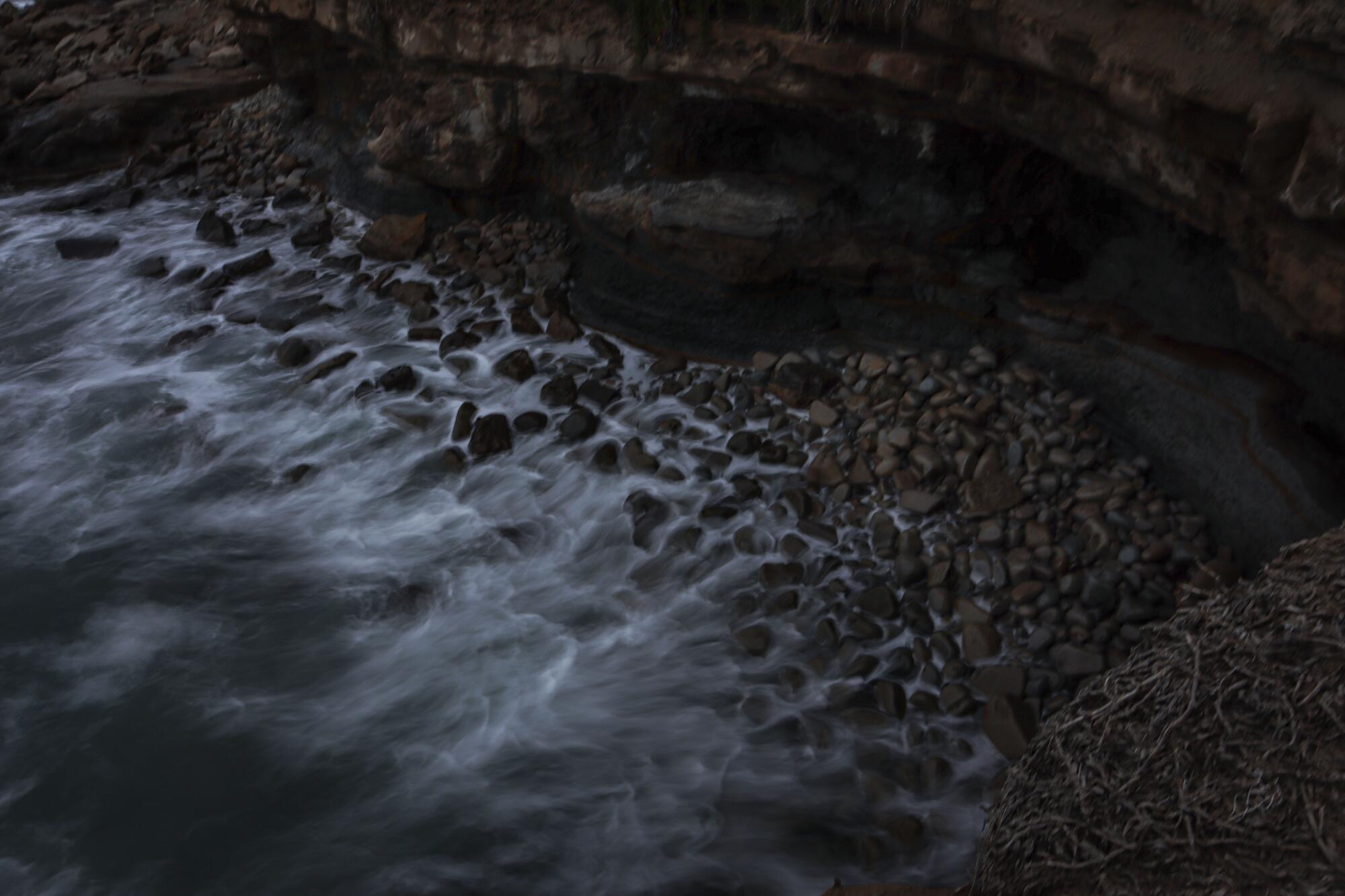
- Share via
SAN DIEGO — Maria Eugenia Chavez Segovia boarded the 40-foot, trawler-like boat with few items: identification, prayer cards, rosary beads and some Mexican pesos.
The 41-year-old from a small town in central Mexico hoped to work in agriculture in California’s San Joaquin Valley. Her aspiration rested on the boat, which she and 31 other migrants with their own ambitions crowded aboard.
But none of them made it to their intended destinations. The boat crashed into a reef off Point Loma on May 2 and splintered.
Chavez Segovia and two others drowned. Another person remains hospitalized, his lungs recovering from resuscitation. The rest are in federal detention as material witnesses to their own attempted smuggling in the unfolding prosecution against the suspected boat captain.
The maritime tragedy served as a stark illustration of how decades of heightened enforcement have pushed many unauthorized cross-border journeys to extremes, sometimes with deadly consequences. And experts fear that coronavirus border restrictions, including the inability to access the asylum system, could lead to a rising death toll.
“We say this is horrible as if it’s something happening in isolation, but it’s been happening as a result of policies we have, and we’re going to keep seeing this happen,” Dulce Garcia, executive director of Border Angels, a nonprofit migrant advocacy group, said of the deaths.
So far this year, at least 110 people have died during attempts to cross the U.S.-Mexico border or as they journeyed north in the interior of Mexico, according to data tracked by the International Organization for Migration.
Remote desert and maritime routes are increasingly popular options for migrants trying to sneak in undetected and avoid being immediately turned back to Mexico under Title 42, a public health rapid-expulsion policy exercised by President Trump and continued under President Biden.
Maritime apprehensions in the San Diego area have increased 92% between fiscal 2019 and 2020, and with 909 arrests so far this year, the region is on track to see an additional 40% rise in incidents at sea, according to U.S. Customs and Border Protection.
For many of the passengers who boarded the boat last weekend, the draw of reuniting with family and children in the United States propelled them to take the expensive and dangerous journey, said Consul General Carlos González Gutiérrez of the Mexican Consulate in San Diego.
“Sometimes they rely on traffickers who might tell them this is really easy. I think it is usually misleading,” González Gutiérrez said in an interview. “They risk more than what they should in order to get across.
“I think it shows you people are desperate, and they are willing to go to extremes in order to come back to the U.S.”
Perilous journey
Chavez Segovia, a single mother, left behind her children and mother in the small town of Amealco de Bonfil in the state of Queretaro. In the U.S., her sister and two brothers — who live in Stockton and Salinas — awaited her arrival, according to Luis Magaña, an advocate of agricultural workers in the San Joaquin Valley.
According to court records, the passengers, all Mexican nationals except for one Guatemalan, had paid $15,000 to $18,000 for the trip. The hefty price is an indicator of the sophistication and specialization of maritime smuggling networks, experts say. Many migrants are able to afford such costs only with help from family, often those who are already working in the U.S.
“This is the business of organized crime,” González Gutiérrez said. “They get involved because of how profitable it is for them.”
To compare, a land route or trip over the border fence usually costs anywhere from $8,000 to $10,000 — a sum that is also pricier than before as those routes have grown more complicated — migrant advocates say.
For this trip, most of the fee was expected to be paid upon successful arrival in the U.S., the consul general said, based on interviews with the passengers.
But for unknown reasons, the boat ran aground about 50 feet off the Cabrillo National Monument in midday currents. Families at the popular tide pools watched as the vessel broke apart and passengers spilled into the ocean. Many struggled to swim, authorities said.

Some witnesses joined what turned into a massive rescue effort.
A few passengers had life vests, authorities said, but it was unknown whether everyone on board had access to one. Dramatic video recorded by witnesses showed some life vests washing ashore.
Victor Perez Degollado, 29, and Maricela Hernandez Sanchez, 35, were pronounced dead upon being pulled from the water.
Chavez Segovia’s siblings, who work in agriculture, saw television reports about the boat wreck and scrambled to find out if their sister survived. They turned to Magaña, who called personal contacts in San Diego and Tijuana. They waited in anguish until Monday, when they got word of Chavez Segovia’s fate.
She had been taken to UC San Diego Medical Center, where she died. All three victims had suffered blunt-force injuries and drowned.
Quick identifications of the deceased were made possible, with help from the Mexican Consulate, because each had identification on them. Many other passengers lost any records they’d brought with them.
In interviews with the Mexican Consulate, the survivors have given some details of the journey. However, the interviews are less fact-finding missions and more focused on connecting Mexican nationals with family, advising them of their legal rights and answering questions about the process ahead.
Being a material witness means survivors will be ordered to remain in the United States — either in detention or possibly released on bond — to possibly testify against the accused boat captain, 39-year-old Antonio Hurtado, a U.S. citizen. Little is known about Hurtado’s alleged role in the smuggling network.
Three people were killed during the apparent human smuggling attempt
The prosecution could take a year or longer, creating a limbo status for the passengers.
“Those who have tried this several times, they are more interested in knowing their legal situation and the possibility of them remaining in the U.S.,” González Gutiérrez said. “Those trying this for the first time, it is my impression, they want to return to Mexico as soon as possible and ask us for help.”
Some survivors who had traveled together from the same hometown have asked consular officials what happened to their companions, if they were among the dead.
Three of the passengers are minors: a girl, 14, and two boys, 15 and 17.
Mexican migration
Migration of single adults from Mexico, particularly in the San Diego region, has jumped in the past year. The reasons are many, said Rafael Fernández de Castro Medina, director of the Center for U.S.-Mexican Studies at UC San Diego.
A top reason is Title 42, which allows for multiple crossing attempts with fewer repercussions, as well as the stark economic downturn that Mexico is facing under the pandemic. Parts of Mexico are also struggling under the continued violence of cartels and gangs, which has in recent years sent asylum seekers from regions like Michoacán and Guerrero fleeing to the U.S. for protection.
“There are more Mexicans coming, and there’s more recidivism because of Title 42,” Fernández de Castro said.
Those choosing to cross by boat or other notoriously dangerous means, Fernández de Castro said, are indicative of the level of desperation caused by the factors driving their migration.
“That’s telling you that there’s very strong push factors in Mexico nowadays,” he said.

Garcia, of Border Angels, hears the desperation daily in the migrant encampments in Tijuana, where vulnerable people from Central America, the interior of Mexico and other nations wait. Some arrived two years ago, biding their time to present asylum claims, only to have the doors closed to them due to the pandemic. Hopes that they would reopen with Biden’s inauguration have quickly faded.
“They fall prey to people telling them they can get across in other ways,” Garcia said. “They’re looking for hope.”
Garcia said that was the case for a teenage boy in March who was offered the chance to cross through the border fence near Calexico. It would be his third — and riskiest — attempt. He climbed into a dangerously overcrowded SUV, which drove through an opening and ultimately crashed in Holtville, killing 13 migrants and injuring him and many others.
Then there are the many migrants who just disappear.
“People regularly call us saying ‘I know my family member tried to reach the U.S. on a boat, but he has not appeared. He is missing,’” said González Gutiérrez.
The Mexican Consulate in San Diego received two such calls a few months ago. In one instance, they secured DNA from family to try to verify the identify of a boy at the Medical Examiner’s Office. In the other case, the woman’s whereabouts remain a mystery.
Return to Mexico
The siblings of Chavez Segovia, who are undocumented immigrants living in the U.S., are arranging to repatriate their sister’s remains, without a personal farewell. Because of their immigration status, they’re afraid of traveling to San Diego, where her body is being stored at a funeral home.
Repatriations usually take two weeks, according to Gabriela Castañeda of Funeraria La Paz, which will repatriate Chavez Segovia. The Mexican Consulate typically provides logistical and some financial assistance in such situations, and in this case has already requested more funding from its government to cover costs, González Gutiérrez said.

The funeral home in Logan Heights will also repatriate the remains of one other passenger who drowned, Degollado.
Castañeda said Degollado’s wife showed up to the funeral home in tears, accompanied by family members. He will be repatriated to the Mexican state of Zacatecas.
The funeral home, which serves mostly families of Mexican descent, has assisted with other immigration-related deaths before, including instances of bodies found in the desert at the border.
Castañeda said sometimes she sees families feeling guilty about supporting their relative’s trek to the U.S. Other times she hears families express regret, saying they had tried to persuade their relative not to embark on the perilous journey or to hold off.
What caught Castañeda’s attention the most in the case of Chavez Segovia’s death were the prayer cards found on her.
“I imagine she was coming entrusted to God,” Castañeda said. “I imagine she prayed to God. I imagine she was coming with the hope of being here, of working, arriving.”
Now Chavez Segovia’s mother and children await her return. Her mother still doesn’t believe her daughter is dead, said Magaña, the family friend.
“Not until she sees a body.”
- Share via
Watch L.A. Times Today at 7 p.m. on Spectrum News 1 on Channel 1 or live stream on the Spectrum News App. Palos Verdes Peninsula and Orange County viewers can watch on Cox Systems on channel 99.
Hernandez and Davis write for the San Diego Union-Tribune. Kate Morrissey of the Union-Tribune contributed to this report.
More to Read
Sign up for Essential California
The most important California stories and recommendations in your inbox every morning.
You may occasionally receive promotional content from the Los Angeles Times.
















